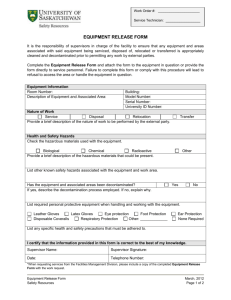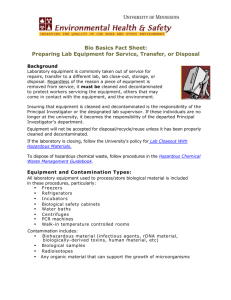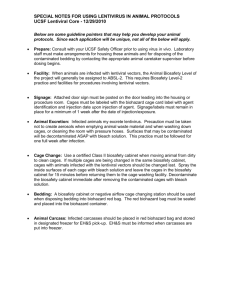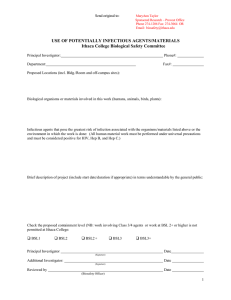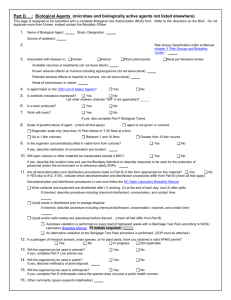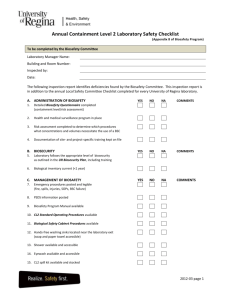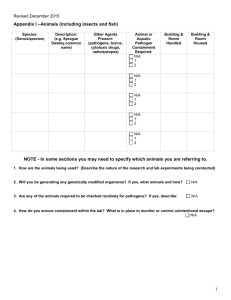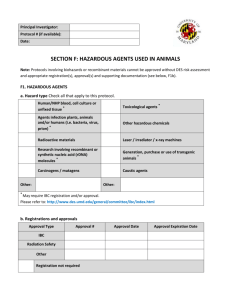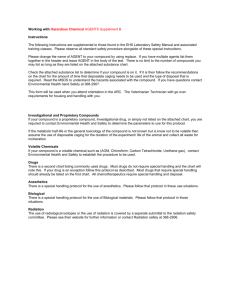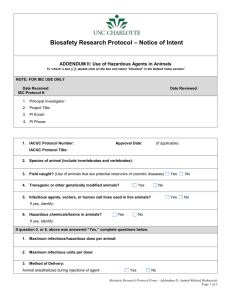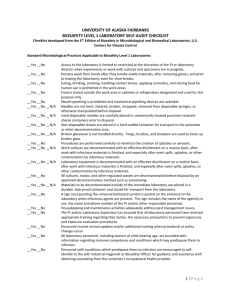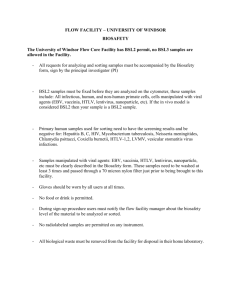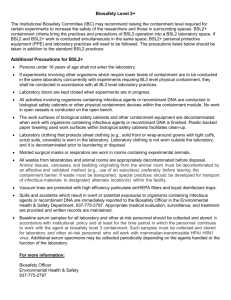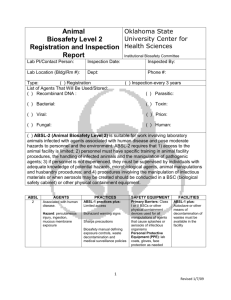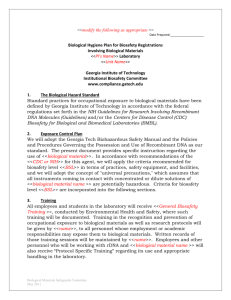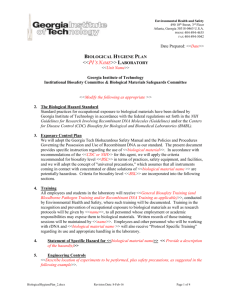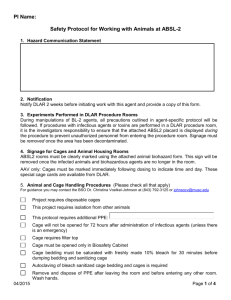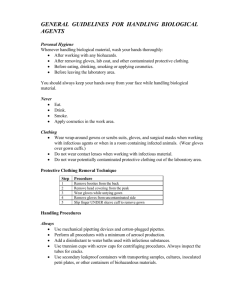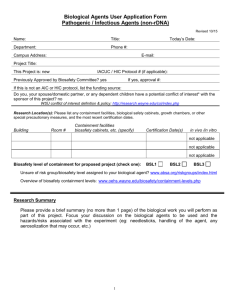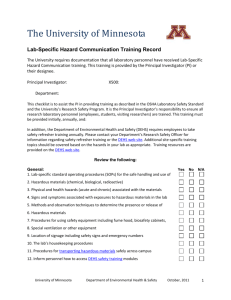Attachment 2 - Use of Potentially Hazardous Agents in Animals
advertisement
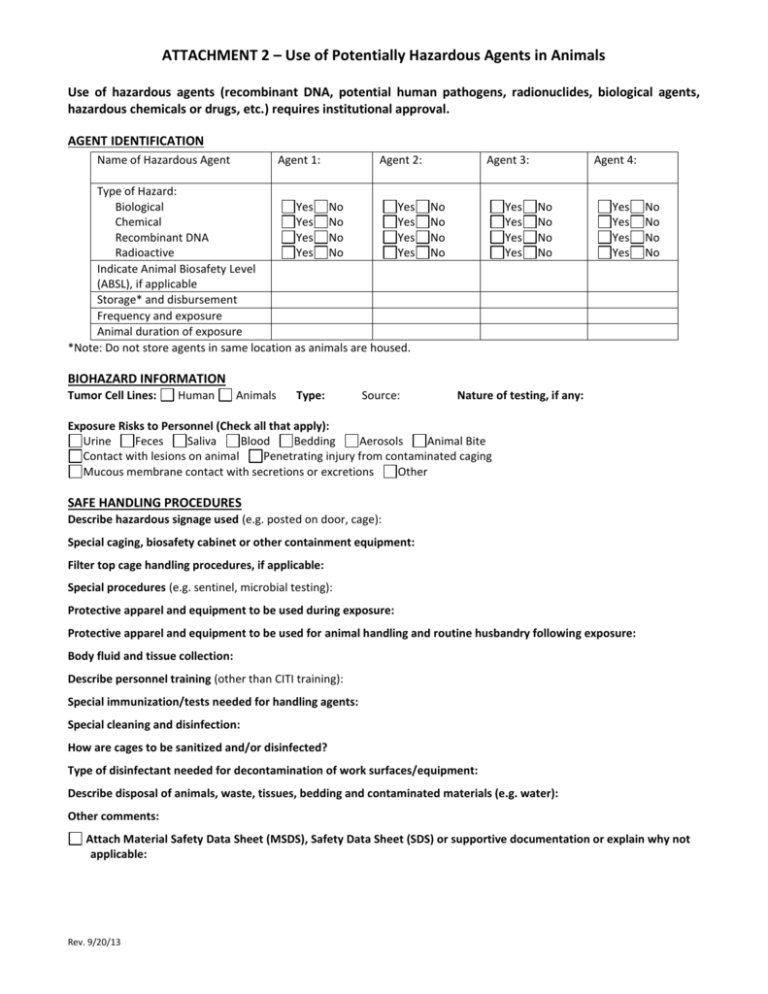
ATTACHMENT 2 – Use of Potentially Hazardous Agents in Animals Use of hazardous agents (recombinant DNA, potential human pathogens, radionuclides, biological agents, hazardous chemicals or drugs, etc.) requires institutional approval. AGENT IDENTIFICATION Name of Hazardous Agent Agent 1: Agent 2: Type of Hazard: Biological Yes No Yes Chemical Yes No Yes Recombinant DNA Yes No Yes Radioactive Yes No Yes Indicate Animal Biosafety Level (ABSL), if applicable Storage* and disbursement Frequency and exposure Animal duration of exposure *Note: Do not store agents in same location as animals are housed. Agent 3: No No No No Yes Yes Yes Yes Agent 4: No No No No Yes Yes Yes Yes No No No No BIOHAZARD INFORMATION Tumor Cell Lines: Human Animals Type: Source: Nature of testing, if any: Exposure Risks to Personnel (Check all that apply): Urine Feces Saliva Blood Bedding Aerosols Animal Bite Contact with lesions on animal Penetrating injury from contaminated caging Mucous membrane contact with secretions or excretions Other SAFE HANDLING PROCEDURES Describe hazardous signage used (e.g. posted on door, cage): Special caging, biosafety cabinet or other containment equipment: Filter top cage handling procedures, if applicable: Special procedures (e.g. sentinel, microbial testing): Protective apparel and equipment to be used during exposure: Protective apparel and equipment to be used for animal handling and routine husbandry following exposure: Body fluid and tissue collection: Describe personnel training (other than CITI training): Special immunization/tests needed for handling agents: Special cleaning and disinfection: How are cages to be sanitized and/or disinfected? Type of disinfectant needed for decontamination of work surfaces/equipment: Describe disposal of animals, waste, tissues, bedding and contaminated materials (e.g. water): Other comments: Attach Material Safety Data Sheet (MSDS), Safety Data Sheet (SDS) or supportive documentation or explain why not applicable: Rev. 9/20/13 Table 1a: Summary of Recommended Biosafety Levels for Activities in Which Experimentally or Naturally Infected Vertebrate Animals Are Used BSL Agents Not known to consistently cause disease in healthy human adults. Practices Standard animal care and management practices, including appropriate medical surveillance programs Safety Equipment (Primary Barriers) As required for normal care of each species. Facilities (Secondary Barriers) Standard animal facility No recirculation of exhaust air 1 Directional air flow recommended Hand washing sink recommended Associated with human disease. Hazard: percutaneous exposure, ingestion, mucous membrane exposure. ABSL-1 practices plus: Limited access ABSL-1 equipment plus primary barriers: containment equipment appropriate for animal species; PPES: laboratory coats, gloves, face and respiratory protection as needed. Biohazard warning signs 2 ABSL-1 facility plus: Autoclave available Hand washing sink available in the animal room. Sharps precautions Mechanical cage washer used Biosafety manual Decontamination of all infectious wastes and of animal cages prior to washing Indigenous or exotic agents with potential for aerosol transmission; disease may have serious health effects. ABSL-2 practices plus: ABSL-2 equipment plus: ABSL-2 facility plus: Controlled access Containment equipment for housing animals and cage dumping activities Physical separation from access corridors Class I or II BSCs available for manipulative procedures (inoculation, necropsy) that may create infectious aerosols. PPEs: appropriate respiratory protection Self-closing, doubledoor access Decontamination of clothing before laundering 3 Cages decontaminated before bedding removed Disinfectant foot bath as needed Sealed penetrations Sealed windows Autoclave available in facility Dangerous/exotic agents that pose high risk of life threatening disease; aerosol transmission, or related agents with unknown risk of transmission. 4 ABSL-3 practices plus: ABSL-3 equipment plus: ABSL-3 facility plus: Entrance through change room where personal clothing is removed and laboratory clothing is put on; shower on exiting Maximum containment equipment (i.e., Class III BSC or partial containment equipment in combination with full body, air-supplied positive-pressure personnel suit) used for all procedures and activities Separate building or isolated zone All wastes are decontaminated before removal from the facility Dedicated supply and exhaust, vacuum and decontamination systems Other requirements outlined in the text Reproduced from "Biosafety in Microbiological and Biomedical Laboratories, BMBL 4th Edition" with permission from the Center for Disease Control (CDC). Rev. 9/20/13
